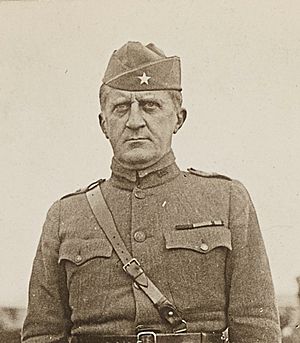Francis Marshall (United States Army officer) facts for kids
Quick facts for kids
Francis Cutler Marshall
|
|
|---|---|

Brigadier General Francis C. Marshall, 1st Division, Meuse 1918.
|
|
| Born | March 26, 1867 Galena, Illinois, U.S. |
| Died | December 7, 1922 (aged 55) Cuyamaca Mountains, California, U.S. |
| Allegiance | |
| Service/ |
|
| Years of service | 1890−1922 |
| Rank | Brigadier General |
| Service number | 0-277 |
| Commands held | 2nd Brigade |
| Battles/wars | World War I |
| Awards | Army Distinguished Service Medal |
Francis Cutler Marshall (born March 26, 1867 – died December 7, 1922) was an important American military leader. He became a brigadier general in the United States Army during World War I. He was known for leading the 2nd Infantry Brigade, which was part of the 1st Infantry Division. For his brave actions during the Meuse-Argonne Offensive, he received the Army Distinguished Service Medal.
Contents
Early Life and Education
Francis Marshall was born in Galena, Illinois, on March 26, 1867. He chose a path of military service from a young age. He attended the United States Military Academy at West Point. This is a famous school where future army officers are trained.
He graduated from West Point in 1890. Many of his classmates also became high-ranking generals. These included Colden Ruggles, Fred W. Sladen, and Edgar Jadwin.
His Military Career

In 1901, Francis Marshall was a captain in the 15th Cavalry. He was stationed at Fort Sheridan, Illinois, for many years. His military career continued to grow.
When the United States joined World War I in 1917, Marshall was sent to France. He showed great leadership during the war. He earned the Distinguished Service Medal. He also received the Croix de Guerre, a French military award. During the war, he was temporarily promoted to brigadier general. After the war, in 1920, he returned to his original rank of colonel.
A Difficult Situation in Kentucky
In February 1920, Governor Edwin P. Morrow of Kentucky asked the U.S. government for help. There were serious problems in Lexington, Kentucky. Colonel Marshall was sent to the city with 1,200 Army soldiers. He arrived by special trains to help restore order.
Marshall put the city under martial law. This meant the military took control to keep the peace. His troops patrolled the area for two weeks. Marshall stated that the community had worked to uphold law and order.
His Final Years and Memorials
Francis Marshall's official home was listed as Darlington, Wisconsin. In his later career, he became the assistant chief of cavalry. On December 7, 1922, he left Rockwell Field for an inspection tour. He was flying with his pilot, Charles F. Webber. They were in a DeHaviland DH4B plane, heading to Tucson.
Sadly, their plane crashed. The wreckage and their remains were found five months later. They were in the Cuyamaca Mountains. It is believed the pilot lost his way in heavy fog. The plane hit treetops and crashed.
The year after his death, a new airfield was named in his honor. This was Marshall Army Airfield at Fort Riley, Kansas. A monument was also built at the crash site on Japacha Ridge in the Cuyamaca Mountains. These memorials remember his service and sacrifice.

